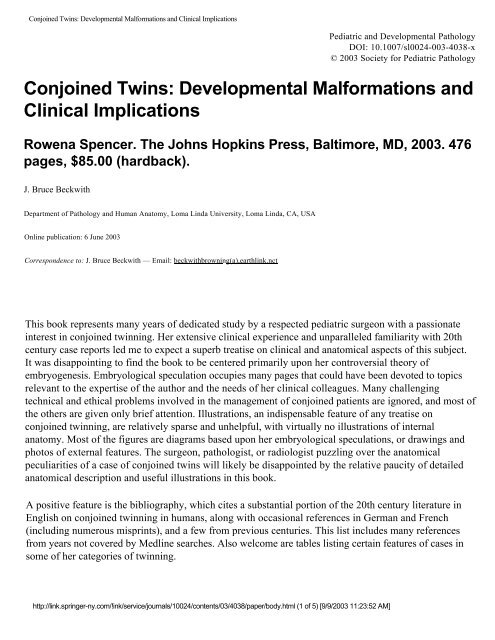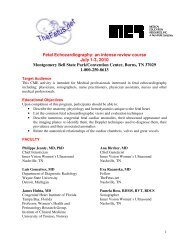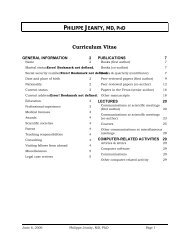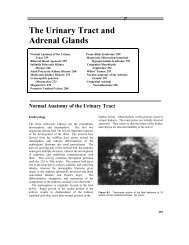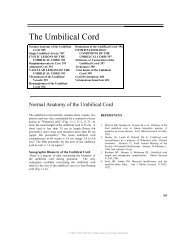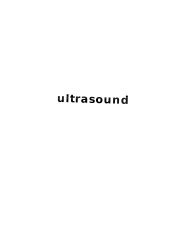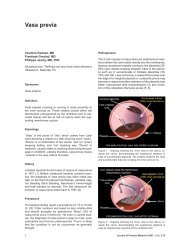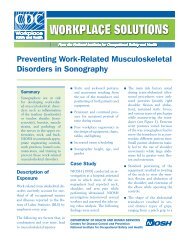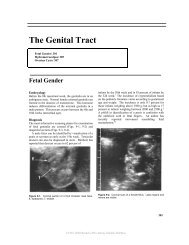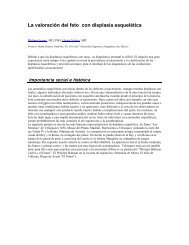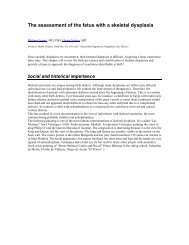Conjoined Twins: Developmental Malformations and ... - SonoWorld
Conjoined Twins: Developmental Malformations and ... - SonoWorld
Conjoined Twins: Developmental Malformations and ... - SonoWorld
Create successful ePaper yourself
Turn your PDF publications into a flip-book with our unique Google optimized e-Paper software.
<strong>Conjoined</strong> <strong>Twins</strong>: <strong>Developmental</strong> <strong>Malformations</strong> <strong>and</strong> Clinical Implications<br />
Pediatric <strong>and</strong> <strong>Developmental</strong> Pathology<br />
DOI: 10.1007/sl0024-003-4038-x<br />
© 2003 Society for Pediatric Pathology<br />
<strong>Conjoined</strong> <strong>Twins</strong>: <strong>Developmental</strong> <strong>Malformations</strong> <strong>and</strong><br />
Clinical Implications<br />
Rowena Spencer. The Johns Hopkins Press, Baltimore, MD, 2003. 476<br />
pages, $85.00 (hardback).<br />
J. Bruce Beckwith<br />
Department of Pathology <strong>and</strong> Human Anatomy, Loma Linda University, Loma Linda, CA, USA<br />
Online publication: 6 June 2003<br />
Correspondence to: J. Bruce Beckwith — Email: beckwithbrowning(a),earthlink.nct<br />
This book represents many years of dedicated study by a respected pediatric surgeon with a passionate<br />
interest in conjoined twinning. Her extensive clinical experience <strong>and</strong> unparalleled familiarity with 20th<br />
century case reports led me to expect a superb treatise on clinical <strong>and</strong> anatomical aspects of this subject.<br />
It was disappointing to find the book to be centered primarily upon her controversial theory of<br />
embryogenesis. Embryological speculation occupies many pages that could have been devoted to topics<br />
relevant to the expertise of the author <strong>and</strong> the needs of her clinical colleagues. Many challenging<br />
technical <strong>and</strong> ethical problems involved in the management of conjoined patients are ignored, <strong>and</strong> most of<br />
the others are given only brief attention. Illustrations, an indispensable feature of any treatise on<br />
conjoined twinning, are relatively sparse <strong>and</strong> unhelpful, with virtually no illustrations of internal<br />
anatomy. Most of the figures are diagrams based upon her embryological speculations, or drawings <strong>and</strong><br />
photos of external features. The surgeon, pathologist, or radiologist puzzling over the anatomical<br />
peculiarities of a case of conjoined twins will likely be disappointed by the relative paucity of detailed<br />
anatomical description <strong>and</strong> useful illustrations in this book.<br />
A positive feature is the bibliography, which cites a substantial portion of the 20th century literature in<br />
English on conjoined twinning in humans, along with occasional references in German <strong>and</strong> French<br />
(including numerous misprints), <strong>and</strong> a few from previous centuries. This list includes many references<br />
from years not covered by Medline searches. Also welcome are tables listing certain features of cases in<br />
some of her categories of twinning.<br />
http://link.springer-ny.com/!ink/service/journals/10024/contents/03/4038/paper/body.html (1 of 5) [9/9/2003 11:23:52 AM]
<strong>Conjoined</strong> <strong>Twins</strong>: <strong>Developmental</strong> <strong>Malformations</strong> <strong>and</strong> Clinical Implications<br />
The embryological theory of the author is that all conjoined twins result from fusion of separate germ<br />
discs. This is presented with an evangelistic zeal that betrays a lack of objectivity, with few qualifications<br />
or expressions of doubt. She assumes that all patterns <strong>and</strong> degrees of twinning are due to the same<br />
mechanism, <strong>and</strong> that fusion <strong>and</strong> fission are the only two mechanisms requiring consideration, so that<br />
disproof of one proves the other. Concepts that might apply to some cases are applied universally. For<br />
example, on page 416, the author expresses without qualification the opinion that teratomas are parasitic<br />
conjoined twins.<br />
Her discussion of the theoretical embryology of "parapagus" twinning (pages 246-247) provides a<br />
particularly disturbing example of fundamental convictions based upon unconvincing evidence. She<br />
dismisses fission as the mechanism of rostral duplications in the following words:<br />
Bifurcation of a single notochord has been proposed (Machin <strong>and</strong> Sperber, 1991), but as<br />
the notochord probably elongates by proliferation at the caudal aspect (O'Rahilly, 1998),<br />
bifurcation during growth should result in caudal, not cranial duplication [italics mine].<br />
The implied support of a leading authority on embryology lends an aura of respectability to this<br />
statement. However, the only reference provided is to a personal communication, <strong>and</strong> the adverb<br />
"probably" seems to be given the status of certainty. That statement constitutes one of two chief<br />
arguments offered as proof that "parapagus" twinning results from fusion of originally separate germ<br />
discs. The other argument is presented in the following words (p. 246):<br />
In a review of the entire spectrum of parapagus—it might seem logical to assume that they<br />
arise from two separate, nearly parallel notochords on one embryonic disc, very close<br />
together caudally but with varying degrees of separation rostrally. However, secondary fusion<br />
of two separate embryonic discs is indicated by the indisputable evidence of duplication of<br />
some portion of the umbilicus, umbilical cord, or placenta in a few parapagus [italics mine].<br />
The reasons why these few "indisputable" cases so conclusively prove her point are not explained<br />
further. No details are provided concerning these cases, <strong>and</strong> I searched in vain for reference to where<br />
they were published. On page 254, it is mentioned that these cases comprised 2% (i.e., 6) of her 305 pairs<br />
of "parapagus" twins. On page 246, it is mentioned that three of them were characterized by "an<br />
additional umbilical vessel," without noting whether these were arteries or veins, or how their number<br />
was documented. Accessory umbilical vessels can result from several developmental mechanisms other<br />
than fusion of separate embryonic discs. These six "indisputable" cases, plus the aforementioned<br />
reference to a statement by Dr. O'Rahilly, are considered sufficient to justify the following sweeping<br />
generalization (p. 246):<br />
All things considered, then, it is postulated that all conjoined twins, including the<br />
parapagus, arise from two individual notochords on two originally separate embryonic<br />
discs [italics mine].<br />
http://link.springer-ny.com/link/service/journals/10024/contents/03/4038/paper/body.html (2 of 5) [9/9/2003 11:23:52 AM]
<strong>Conjoined</strong> <strong>Twins</strong>: <strong>Developmental</strong> <strong>Malformations</strong> <strong>and</strong> Clinical Implications<br />
Dr. Spencer's speculations on the fusion-fission controversy resurrect a debate that was popular during<br />
the 18th <strong>and</strong> early 19th centuries, when embryology was primarily the domain of philosophers. During<br />
the latter part of the 19th century, this question was subjected to scientific investigation, especially in the<br />
great embryological laboratories of Germany. It was soon recognized that the original philosophical<br />
concepts, designated in German as the "Spaltungstheorie" <strong>and</strong> "Verwachsungstheorie" ("fission" <strong>and</strong><br />
"fusion" theory), were too simplistic. Though the evidence was more favorable to the "fission" theory<br />
(i.e., incomplete separation of monozygotic twins), it was also apparent that the induction <strong>and</strong><br />
organization of body axes was more complex than these terms implied. Fusion versus fission was<br />
rephrased in terms more relevant to evolving concepts of developmental mechanics. The monographs of<br />
Schwalbe [1] <strong>and</strong> Hiibner [2] provide detailed overviews of experimental studies into the developmental<br />
mechanisms of conjoined twinning in the decades preceding the First World War. Hiibner's monograph<br />
[2], published in 1911, includes an appropriate epitaph for the simplistic fusion-fission controversy (p.<br />
792):<br />
"Verschmelzung 1 oder "Spaltung 1 , dies beiden Worte, die einst so heftige Discussionen<br />
verursachten, sind heute blosse Worte ['Fusion' or 'splitting,' these words that once<br />
provoked such violent controversy, are now empty words].<br />
In 1923, Newman's analytical review of the embryology of twins [3] added several new arguments<br />
refuting fusion as the mechanism for most cases of conjoined twinning, <strong>and</strong> that concept received little<br />
support in the following decades. The experimental embryology of conjoined twinning has now been<br />
extended to the molecular level. One model involves the production of axial duplications in xenopus<br />
larvae by injection of components of the Wnt/beta-catenin cascade at the 2 to 8-celled stage [4 5].<br />
Comparable results are reported in zebrafish [6]. The formation <strong>and</strong> development of two-headed embryos<br />
<strong>and</strong> other axial duplication anomalies can be observed continuously in vivo. These <strong>and</strong> numerous other<br />
experimental models developed over more than a century provide substantial evidence inconsistent with<br />
Spencer's fusion theory of "parapagus" twinning. The existence of that literature is briefly mentioned in<br />
Spencer's chapter 2, but is dismissed on the basis that animal models do not necessarily apply to humans.<br />
Perhaps experimental embryology would not have been dismissed so casually if it had provided more<br />
support for her speculations. Armchair embryology may suffice for politicians <strong>and</strong> theologians, but is a<br />
poor substitute for descriptive <strong>and</strong> experimental science.<br />
Chapter 9 is devoted to the "rachipagus" pattern, a novel category of conjunction introduced by Dr.<br />
Spencer in 1995 [7]. She considers this to be the pattern providing the most convincing proof of her<br />
developmental theory. <strong>Twins</strong> joined back-to-back, with fusion of spinal columns above the sacrum, were<br />
not believed to exist until Dr. Spencer discovered a suggestive case report in a French regional medical<br />
journal [8]. That report (which I have not seen) was a radiographic study of 7-month fetuses said to be<br />
joined back-to-back. No photographs or anatomical details are provided. The radiograph, as reproduced<br />
on page 333 <strong>and</strong> in Spencer's 1995 article, depicts two individuals that appear to have posterior fusion of<br />
skulls, two faces directed in opposite directions, <strong>and</strong> apparent coalescence of vertebrae T6 to L3. The<br />
spinal columns diverged in the lumbar <strong>and</strong> cervical regions. The reproduced image is small <strong>and</strong><br />
http://link.springer-ny.com/link/service/journals/10024/contents/03/4038/paper/body.html (3 of 5) [9/9/2003 11:23:52 AM]
<strong>Conjoined</strong> <strong>Twins</strong>: <strong>Developmental</strong> <strong>Malformations</strong> <strong>and</strong> Clinical Implications<br />
somewhat fuzzy. Though it appears impressive, it conceivably could be misleading. "Janiform"<br />
cephalothoracopagus twins, connected ventrally from umbilicus to vertex with two composite faces<br />
oriented in opposite directions, might yield a similar appearance if the orientation of the radiograph was<br />
perpendicular to the midfacial axis, with the two spinal columns partially superimposed, <strong>and</strong> each pelvis<br />
was rotated approximately 90 degrees to face the same direction as one of the faces.<br />
A few bizarre cases reported in Table 9-1 <strong>and</strong> in a 1996 article by Spencer et al. [9] are offered as<br />
possible examples of rachipagus twinning, but none provides convincing proof of her interpretation.<br />
Taruffi's monumental review of the world literature up to the early 1880's [10] disclosed no anatomically<br />
confirmed case similar to that depicted in the French radiological paper, <strong>and</strong> a Medline search reveals no<br />
recent reports of similar cases. Furthermore, I have not found a convincing description of this type of<br />
twinning in another vertebrate species. Before adding the rachipagus pattern to the list of established<br />
patterns of conjoined twins, I would like to see more anatomical evidence than the aforementioned single<br />
radiograph.<br />
The designation of rachipagus is not my only concern about the classification scheme <strong>and</strong> nomenclature<br />
proposed by Dr. Spencer, which is based primarily upon her embryological theory. It adds new areas of<br />
confusion <strong>and</strong> controversy without resolving old ones. Simplification is achieved by lumping the most<br />
difficult <strong>and</strong> controversial patterns of twinning together into a single "atypical" category. Novel words<br />
are introduced <strong>and</strong> older terms are given new meanings. While insisting upon precision in the application<br />
of some terms, she is imprecise in others. For example, "omphalopagus" has long been used for ventral<br />
supraumbilical conjunction confined to the umbilicus or cord, but Dr. Spencer extends the use of this<br />
term to all cases in the thoracopagus series with separate hearts, regardless of the degree of thoracic<br />
conjunction. Cardiac anatomy is so dominant a consideration in the surgical evaluation of conjoined<br />
twins that there is no obvious need to incorporate it into the name of the twinning pattern at the cost of<br />
anatomical precision.<br />
Creation of the "parapagus" category is, in my view, a particularly unfortunate one. This designation is<br />
proposed for a spectrum of patterns traditionally viewed as axial duplications, most often observed in the<br />
anterior (or rostral) end of the axis. The "parapagus" designation reflects Spencer's fusion theory, which<br />
seems unlikely to achieve wide acceptance. Existing designations for rostral <strong>and</strong> caudal axial<br />
duplications accurately describe the anatomy of this pattern, <strong>and</strong> are consistent with the findings of<br />
experimental <strong>and</strong> descriptive embryology.<br />
Without belaboring all my reservations about this classification scheme, I will simply offer the opinion<br />
that problems involving conjoined twins are not likely to be resolved by new taxonomies. In the<br />
molecular era, new paradigms might lead to entirely different ways of thinking about twinning, but until<br />
then I plan to muddle along with the familiar imperfections of existing terminologies rather than<br />
accepting this new one.<br />
My affection <strong>and</strong> respect for the author, with whom I have enjoyed a cordial correspondence for many<br />
years, makes it especially painful to express so many negative comments about a book that represents so<br />
http://link.springer-ny.com/link/service/joumals/10024/contents/03/4038/paper/body.html (4 of 5) [9/9/2003 11:23:52 AM]
<strong>Conjoined</strong> <strong>Twins</strong>: <strong>Developmental</strong> <strong>Malformations</strong> <strong>and</strong> Clinical Implications<br />
much time <strong>and</strong> effort, <strong>and</strong> is so dear to her heart. My disappointment in this book reflects the height of<br />
my expectations. If only she had left embryology to embryologists <strong>and</strong> focused upon clinical anatomy,<br />
she could have created a splendid work of permanent value. In spite of its disappointing features, it is the<br />
most extensive monograph on this topic in the English language, <strong>and</strong> contains information not easily<br />
found elsewhere. It therefore deserves a place on the shelves of those who deal with these amazing <strong>and</strong><br />
eternally challenging patients.<br />
References<br />
1. Schwalbe E (1907) Morphologie der Missbildungen des Menschen und der Tiere, Teil II: Die Doppelbildungen. Gustav<br />
Fischer, Jena, Germany<br />
2. Hiibner H (1911) Die Doppelbildungen des Menschen und der Tiere. Ergebnisse der Allgemeinen Pathologie und<br />
Pathologischen Anatomie des Menschen und der Tiere 15:649-796 [PubMedl<br />
3. Newman HH (1923) The Physiology of Twinning. University of Chicago Press, Chicago<br />
4. Molenaar M, van de Wetering M, Oosterwegel M, et al. (1996) XTcf-3 transcription factor mediates beta-catenininduced<br />
axis formation in Xenopus embryos. Cell 86:391-399 [PubMedl<br />
5. McMahon AP, Moon RT (1989) Ectopic expression of the proto-oncogene int-l in xenopus embryos leads to<br />
duplication of the embryonic axis. Cell 58:1075-1084 [PubMedl<br />
6. Kelly GM, Erezyilmaz DF, Moon RT (1995) Induction of a secondary embryonic axis in zebrafish following the<br />
overexpression of beta-catenin. Mech Dev 53:261-273 [PubMedl<br />
7. Spencer R (1995) Rachipagus conjoined twins: they really do occur! Teratology 52:346-356 [PubMedl<br />
8. Betoulieres P, Caderas de Kerlau J, Gevaud<strong>and</strong> L, et al. (1960) Etude radiologique de squelette d'un monstre double<br />
janicephale-rachipage. Montpellier Med J 58:30-39 [PubMedl<br />
9. Spencer R, Chuaqui B, Garcia CJ (1996) Anencephaly, dorsal hypermelia, <strong>and</strong> duplication of the vertebral column: a<br />
rare type of rachipagus conjoined twins. Teratology 53:253-260 [PubMedl<br />
10. Taruffi C (1881-1894) Storia dell Teratologia, 8 volumes. Regia Tipografica, Bologna, Italy<br />
http://link.springer-ny.com/link/service/joumals/10024/contents/03/4038/paper/body.html (5 of 5) [9/9/2003 11:23:52 AM]


